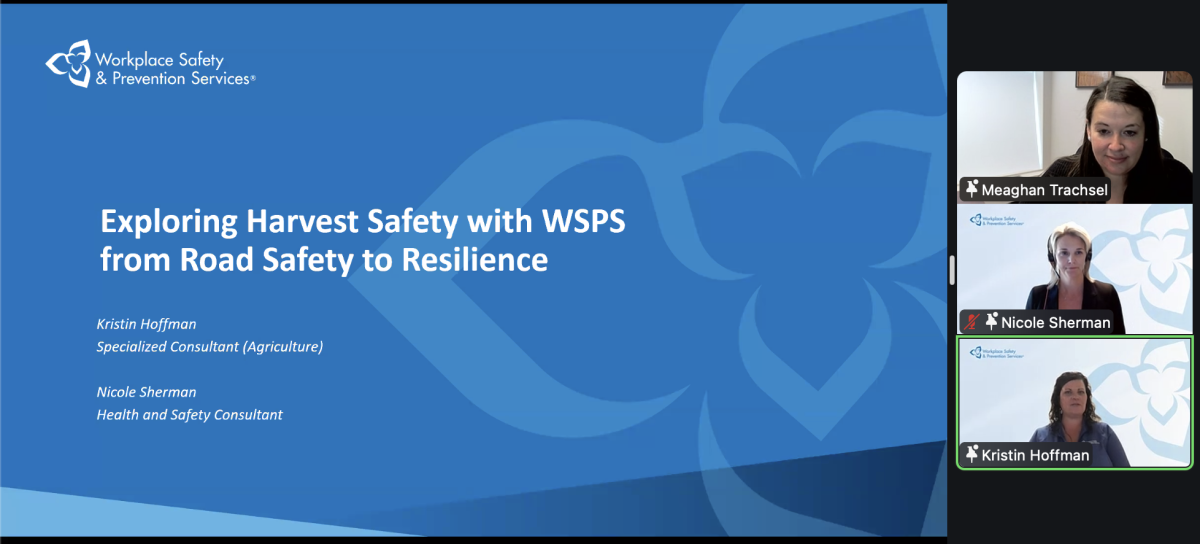Current players in Canada’s beef slaughter and processing sector are among those winning more public funding in Thursday’s federal budget.
The agriculture sector generally will continue to rely on the previously-budgeted Growing Forward farm program policy framework for federal and provincial funding, but Finance Minister Jim Flaherty’s 2010 budget has laid out renewed funding for some programs and a number of smaller initiatives of interest to farmers and rural residents.
The federal Agricultural Flexibility Fund, introduced in Flaherty’s January 2009 budget, will put up $40 million over three years toward developing and commercializing “innovative technologies” to remove and use specified risk materials.
Read Also

Exploring Harvest Safety
Kristin Hoffman of WSPS explains measures for increased farm safety around harvest season
SRMs, tissues such as the brain, spinal cord and attached nerve ganglia, are known to harbour the protein that causes BSE in affected animals.
Currently all SRMs must be removed from carcasses at slaughter for Canada to keep its status as a “controlled risk” country for BSE. But disposal remains a challenge for packers who can’t ship those materials to any rendering plant, as SRMs are banned from use in animal feeds, pet foods and fertilizer.
The funding Flaherty pledged Thursday is meant to back technologies that help packers to reduce SRM handling costs and create “potential revenue sources” from SRMs.
Thursday’s budget also commits $10 million from the $500 million Agricultural Flexibility Fund as a top-up for the budget of the federal Slaughter Improvement Program in 2010–11, to support the introduction of “new, cost-effective technologies.”
On top of that, Flaherty on Thursday targeted $25 million in 2010–11 from the fund to support processing plants that handle cattle over 30 months of age.
Food security
Thursday’s budget also pledged funding for food security programs both domestically, in remote northern communities, and internationally, in countries where farming productivity is subpar.
The 2010 budget commits $45 million over two years for a retooling of the federal Food Mail Program that has run out to northern communities since the late 1960s.
On top of existing funding, Thursday’s budget brings the Food Mail annual budget to $60 million, meant to “alleviate the costs of shipping healthy foods by air to isolated communities and include activities to encourage nutritious eating.”
Specifically, that means new focus on supporting a basket of healthy foods based on Canada’s Food Guide, and on laying out a process for ensuring program sustainability.
The federal Indian affairs and northern development ministry is expected to announce more details on the new program “in the coming months.”
Also, as a follow-up on commitments Canada made at the 2009 G8 summit in earthquake-damaged L’Aquila, Italy for a three-year, $600 million agriculture package, Flaherty said $260 million is to be provided through the World Bank to its Global Food Crisis Response Program and its new Global Agriculture and Food Security Program.
Canada’s contribution “provides resources to enhance agricultural productivity and to improve long-term food security for poor and vulnerable populations,” the budget papers said.
National credit unions
The budget also offered an advance look at legislation affecting what in many rural communities is the only financial services provider: the local credit union.
Flaherty pledged that the government will introduce a legislative framework allowing credit unions to incorporate and continue their usual operations as federal entities.
“Allowing credit unions to grow and be competitive on a national scale will broaden choices for consumers by helping credit unions to attract new members and improve services to existing members across provincial borders,” the budget papers said.
The budget also noted that legislation may need to include changes to the Income Tax Act, so federal credit unions which satisfy that Act’s definition of “credit union” would be subject to the same income tax rules as other credit unions.
Also on paper
Flaherty’s budget also offered up other programs, projects and funding relevant to farmers and/or rural Canadians, including:
- eliminating “all remaining tariffs” on manufacturing inputs and machinery and equipment being imported into Canada, with most tariffs to be removed by Friday (March 5) and some to be gradually eliminated between now and Jan. 1, 2015;
- $38 million over two years toward the federal Invasive Alien Species Strategy, to reduce the risk of invasive animal and plant species being introduced to Canada;
- $32 million over the next two years for the Regional and Remote Passenger Rail Services Contribution Program, which helps support the Keewatin Railway in Manitoba; the Algoma Central Railway and Ontario Northland Transportation Commission; and the Tshiuetin Rail Transportation in Quebec and Labrador;
- $11 million per year, ongoing, for the Community Futures Program, which promotes community and economic development in rural Canada;
- choosing successful applicants this year from among 570 proposals submitted by last October’s deadline to Broadband Canada, for projects to “expand broadband coverage to as many unserved and underserved households in Canada as possible;” and
- confirming $51.7 million over two years to support the operations of the Canadian Grain Commission.
The CGC “plays a crucial role in establishing and ensuring standards of quality for Canadian grain,” the budget papers said, but “rapidly changing global and domestic markets for grain require that the commission become a more flexible institution.
“The government remains committed to modernizing the Canadian Grain Act and the operations of the Canadian Grain Commission, and working with Canadian grain farmers to promote marketing freedom to address evolving needs of the sector.”
















